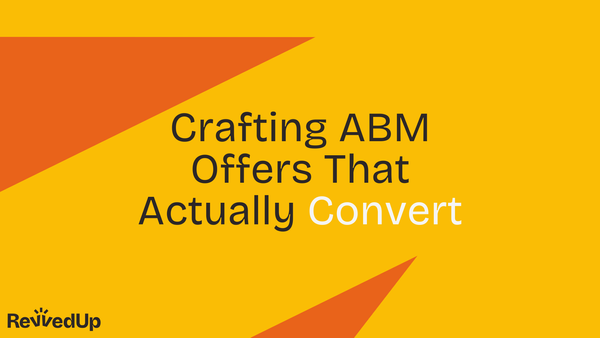The Secrets to Sales Velocity Growth

Sales velocity is a crucial metric in sales. It gives you a mathematical formula to predict your quota attainment. It's like a crystal ball! Read on to see how to calculate sales velocity and most importantly, explore the tactics you can use to increase it.
Sales velocity is a crucial metric in sales. It gives you a mathematical formula to predict your quota attainment for any given period. It's like a crystal ball!
Not only that, but you can use it to figure out where to improve. By tracking the number of opportunities, average deal value, close rates, and sales cycle length, you can measure the impact of factors like SDR hiring, qualification training and discounting on your future revenue output.
In this blog, we'll explore these variables, show you how to calculate sales velocity and most importantly, explore the tactics you can use to increase it.
Understanding the Concept of Sales Velocity
Sales velocity is a crucial sales metric that measures how much revenue you will make in a given period of time, given the same set of standard inputs. It provides valuable insights into the efficiency and effectiveness of your sales process. By analyzing sales velocity, you can identify bottlenecks and optimize your sales pipeline to drive faster deal closures.
Here is the formula, courtesy of Hubspot:
Understanding sales velocity is essential for salespeople and sales managers alike. It helps you gauge the performance of your sales team, identify areas for improvement, and align your sales efforts with customers' needs and preferences. By increasing your sales velocity, you can accelerate revenue growth and drive business success.
Importance of Sales Velocity for Startups and VC-Backed Businesses
High sales velocity plays a critical role for startups and VC-backed businesses, especially when it comes to demonstrating growth potential to investors. It serves as an essential sales metric that showcases a healthy business with a steady stream of future revenue.
By analyzing the speed at which deals move through the sales cycle, startups and VC-backed businesses can gain insights into their growth trajectory. It allows them to identify bottlenecks, optimize their sales process, and make data-driven decisions to drive more revenue. Using accurate data and the sales velocity equation, businesses can strategically focus on increasing sales performance, serving customers' needs, and ultimately accelerating their growth.
Calculating Sales Velocity: The Four Crucial Variables
When it comes to calculating sales velocity, there are four crucial variables that need to be considered: the number of opportunities (#), average deal value ($), close rate (%), and sales cycle length (days).
These variables play a significant role in determining how likely it is your different reps will hit their quota targets, and contribute to overall sales performance. By accurately analyzing these variables, businesses can gain valuable insights into their sales metrics and identify areas for improvement.
Now let's dive into the 4 core components of sales velocity.
Opportunities: The Building Blocks of Sales
The success of sales velocity relies heavily on the number of opportunities in the sales pipeline. By increasing the quantity of qualified leads, businesses can effectively accelerate their sales velocity. This means more chances to convert prospects into paying customers and ultimately generate revenue.
The number of opportunities, which represents the number of qualified leads in your pipeline, directly impacts the overall performance of salespeople. In order to maximize sales velocity, it is crucial to have an accurate data-driven approach that focuses on the total number of opportunities and the length of time it takes to close deals. By prioritizing opportunities and nurturing leads effectively, businesses can achieve greater sales velocity and drive growth.
Average Deal Value: Impact on Sales Velocity
When it comes to sales velocity, the average deal value plays a crucial role. By increasing the average deal value, companies can significantly impact their sales velocity through increasing revenue per deal. By focusing on increasing the average deal value, companies can not only boost their sales velocity but also improve their overall sales performance. So, if you want to accelerate your sales velocity, consider the impact of your average deal value.
Close Rate: Turning Prospects into Customers
A high close rate is a strong indicator of efficient lead qualification and contributes to a higher sales velocity. It is crucial to focus on lead qualification and ensure that prospects are effectively turning into paying customers. By utilizing accurate data and implementing strategies to optimize the close rate after they've been qualified as an opportunity, businesses can maximize their sales performance and meet customers' needs more effectively. The close rate plays a significant role in the success of a sales team and the overall growth of the business. It is essential to continuously analyze and improve this crucial sales metric to drive sales velocity and achieve long-term success.
Sales Cycle Length: Time is Money
Shortening the sales cycle length can have a significant impact on sales velocity and revenue generation. By analyzing and optimizing each stage of the sales cycle, you can reduce the cycle length and ultimately boost your sales performance. The shorter sales cycle length refers to the number of days it takes for a lead to progress through the entire sales process and become a paying customer. By reducing the length of time it takes to convert leads, you can increase the number of deals closed within a given time period, resulting in more revenue for your business and more productive reps.
Analyzing accurate data on how prospects progress through you sales cycle at different stages can help you identify bottlenecks in your sales process and take steps to address them. Remember, time is money in sales, and shortening your sales cycle can lead to faster revenue growth.
Amplifying Sales Velocity: Practical and Pragmatic Tips
Increasing sales velocity requires practical and pragmatic approaches. One way to achieve this is by increasing the number of opportunities. By expanding your reach and attracting more leads, you can create a larger pool of potential customers, which can lead to higher sales velocity. This may involve increased investments in demand generation programmes, attending industry events or hiring SDRs.
Another effective strategy is streamlining the sales process and eliminating bottlenecks. By analyzing each stage of the sales process, you can identify areas that may be causing delays or hindering progress. By addressing these issues and implementing solutions, you can accelerate sales velocity through a smoother and more efficient sales cycle.
Lets dive deeper into the various options you have to drive sales velocity and, ultimately, revenue.
Increasing the Number of Opportunities
To increase the number of sales opportunities in the pipeline, it is crucial to implement effective lead generation strategies. By targeting the right audience and leveraging various marketing channels, you can generate high-quality leads. This means identifying and attracting potential customers who are more likely to convert into paying customers. Lead generation is an essential aspect of sales velocity growth, as it ensures a continuous influx of potential deals into your pipeline.
By focusing on generating high-quality leads, you can increase the chances of closing more deals and ultimately driving revenue growth. With accurate data and a well-executed lead generation strategy, you can significantly boost your sales velocity and achieve your business goals.
If you don't have the resources or talent in your startup to execute a marketing-led lead generation programme, then consider hiring SDRs (or working with an outsourced partner that offers these services) to help you book more qualified meetings and ultimately feed your pipeline.
Enhancing the Average Deal Size
To enhance the average deal size and make your offer more valuable to your target audience, there are several strategies you can implement.
One approach is to upsell or cross-sell additional products or services to your customers, thereby increasing the deal value. Another tactic is to offer customized solutions that cater to the specific needs of each customer, ensuring that they see the added value in their purchase.
Pricing strategies play a crucial role in maximizing revenue without compromising customer satisfaction. By providing add-ons or upgrades that enhance the initial purchase, you can further increase the average deal size.
Coaching can also have a huge impact here, such as helping your reps learn how to 'sell to power' (i.e. more senior decision makers) and uncover more strategic pains points that senior executives are willing to pay more money to solve.
Optimizing your Close Rates
To optimize the close rate, it is crucial to streamline the sales process and eliminate any bottlenecks that may hinder efficiency. Additionally, improving lead generation strategies is essential for attracting high-quality leads that are more likely to convert.
Sales reps should be trained to effectively communicate the value proposition and address customer objections, ensuring a higher conversion rate. Utilizing CRM tools can aid in tracking and analyzing the conversion rate at each stage of the sales funnel, providing valuable insights for making improvements.
Best practices for qualifying leads and identifying decision-makers should also be implemented to increase conversion rates. By implementing these strategies, businesses can optimize their conversion rates and drive growth.
Reducing the Sales Cycle Length
Reducing the Sales Cycle Length means identifying and addressing any inefficiencies or delays in the sales process. By streamlining the qualification process, sales reps can quickly identify high-potential opportunities. Providing them with the necessary resources and support helps move deals forward efficiently, which is why many scaling organisations invest heavily in sales enablement.
Leveraging technology and automation for repetitive tasks reduces manual effort and saves time. Continuous monitoring and optimization of the sales cycle help identify and eliminate bottlenecks. By reducing the length of your sales cycle, you can close deals faster, acquire new customers, and generate more revenue.
It's important to have accurate data and utilize the sales velocity formula to calculate the sales metric. This enables you to measure the effectiveness of your sales cycle and identify areas for improvement.
Do Fast Moving Deals Equate to High Sales Velocity?
Fast-moving deals may suggest high sales velocity, but it's important to consider other factors. The size of deals and the revenue generated also impact sales velocity. A high volume of small deals may result in a fast-moving sales cycle but not necessarily high sales velocity. Analyze the overall impact on revenue and business growth, focusing on both the speed and value of deals.
How Sales Velocity can Accelerate Your Business Growth
Sales velocity plays a crucial role in accelerating business growth in the long run. By increasing sales velocity, businesses can deliver more consistent and predictable revenue at a higher rate per rep.
This ultimately leads to higher revenue generation in less time. Optimizing sales velocity also enables organizations to focus on high-quality leads and improve win rates, ensuring that valuable resources are invested in the right opportunities.
By leveraging accurate data and insights provided by sales velocity, businesses can make more informed strategic decisions that drive growth.
Conclusion
Understanding and leveraging sales velocity is crucial for business growth and maximizing sales. By focusing on four key variables - opportunities, deal value, close rate, and sales cycle length - you can optimize your sales process and generate revenue faster.
Startups and VC-backed businesses benefit greatly from harnessing the power of sales velocity to achieve rapid growth and attract investment. However, it's important to note that fast deals don't always mean high sales velocity, particularly if the other variables like deal size, number of opportunities and close rates all go into reverse.
Implementing practical strategies such as increasing opportunities, enhancing deal size, optimizing conversion rates, and reducing the sales cycle can amplify your sales velocity, increase total revenue and propel your business forward more predictably.




